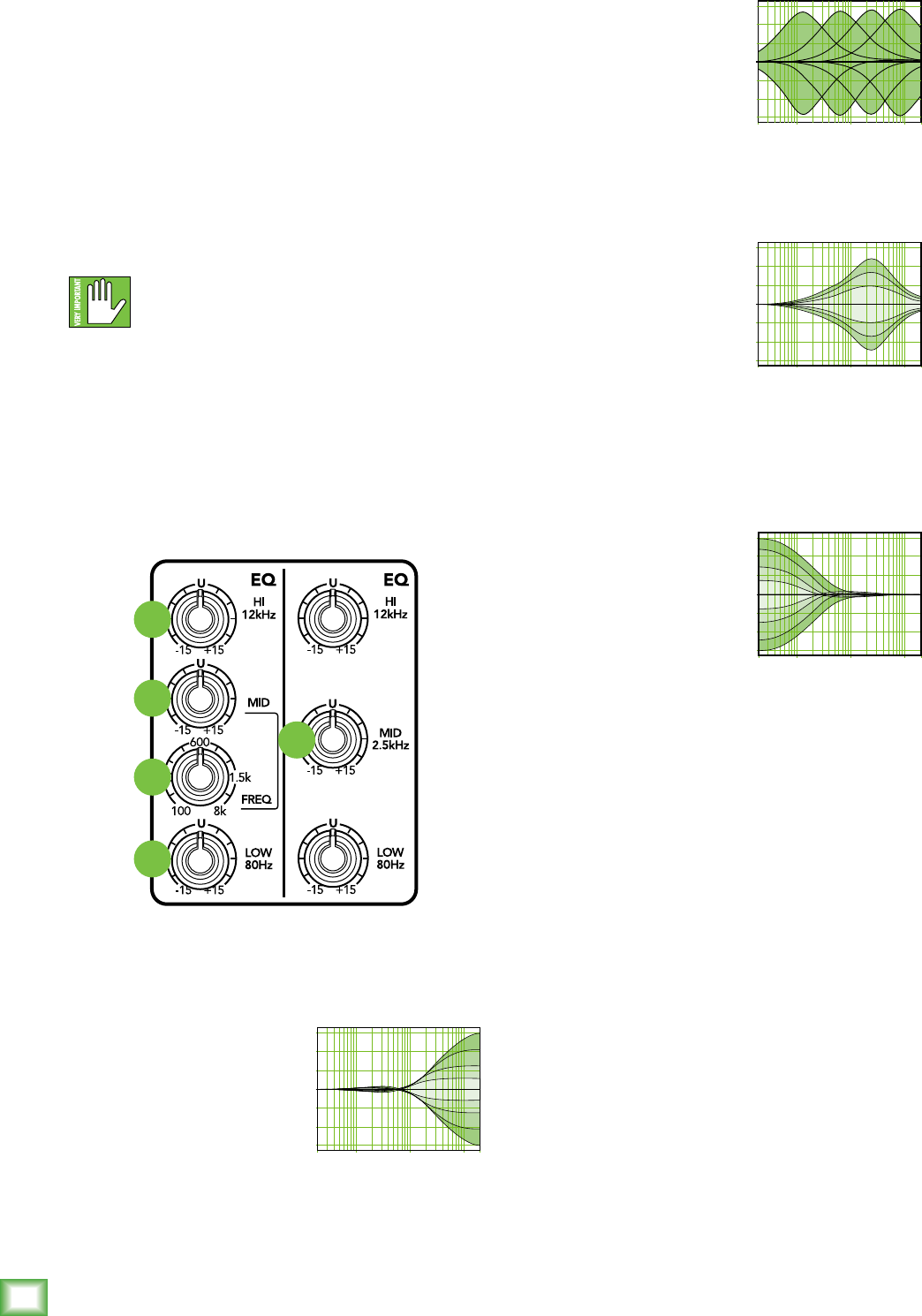
ProFX8v2 • ProFX12v2 • ProFX16v2 • ProFX22v2 • ProFX30v2
12
ProFX8v2 • ProFX12v2 • ProFX16v2 • ProFX22v2 • ProFX30v2
Channel Equalization (EQ)
All ProFXv2 mono channels – except for the
ProFX4v2, which is covered in its own owner's manual
– have 3-band EQ with shelving hi, peaking mid with
adjustable mid frequency [ProFX16v2, ProFX22v2,
ProFX30v2] and shelving low. The stereo channels
have a peaking mid EQ control in addition to the
shelving hi and shelving low EQ controls.
Shelving means that the circuitry boosts or cuts all
frequencies past the specified frequency. For example,
the low EQ boosts bass frequencies below 80 Hz and
continuing down to the lowest note you never heard.
Peaking means that certain frequencies form a “hill”
around the center frequency.
With too much EQ, you can really upset things.
We’ve designed a lot of boost and cut into each
equalizer circuit because we know that
everyone will occasionally need that. But if you max the
EQ on every channel, you’ll get mix mush. Equalize
subtly and use the left sides of the knobs (cut), as well
as the right (boost). If you find yourself repeatedly using
a lot of boost or cut, consider altering the sound source,
such as placing a mic differently, trying a different kind
of mic, a different vocalist, changing the strings, or
gargling.
13. Hi EQ
The hi EQ provides up to
15 dB of boost or cut above
12 kHz, and it is also flat
(no boost or cut) at the
detent. Use it to add sizzle
to cymbals, an overall sense
of transparency, or an edge to keyboards, vocals, guitar
and bacon frying. Turn it down a little to reduce
sibilance or to mask tape hiss.
17
15
14
16
13
20
Hz
100
Hz
1k
Hz
10k
Hz
20k
Hz
–15
–10
–5
0
+5
+10
+15
14. Mid EQ
15. Freq
[ProFX16v2, ProFX22v2, ProFX30v2]
The mono channels employ
a semi-parametric mid-sweep
EQ. The gain (up to 15 dB
of boost or cut) is set via the
mid EQ, and then “aimed” at
a specific frequency, from
100 Hz to 8 kHz, via the freq
control.
16. Mid EQ
Short for “midrange,” this
knob provides up to 15 dB of
boost or cut, centered at
2.5 kHz, also flat at the center
detent. Midrange EQ is often
thought of as the most
dynamic, because the frequencies that define any
particular sound are almost always found in this range.
You can create many interesting and useful EQ changes
by turning this knob down as well as up.
17. Low EQ
The low EQ provides up to
15 dB of boost or cut below
80 Hz. The circuit is flat at
the center detent position.
This frequency represents the
punch in bass drums, bass
guitar, fat synth patches, and some really serious male
singers who eat raw beef for breakfast.
18. Aux Mon
These knobs tap a portion of each channel's signal to
set up a nice monitor mix feeding stage monitors,
independent of the main mix. Adjust these controls on
each channel until the band is happy with the stage
monitor mix.
The controls are off when fully turned down, deliver
unity gain at the center detent, and can provide up to
15 dB of gain turned fully up.
The pan, mute and channel fader do not affect the
monitor output, but the other channel controls will.
The aux mon is pre-fader.
The overall output level may be adjusted with the aux
master mon controls and monitor 1's EQ tweaked with
the graphic EQ if the main mix/mon 1 switch is engaged.
Internal FX may also be added to the monitor mix with
the internal FX to mon knobs.
20
Hz
100
Hz
1k
Hz
10k
Hz
20k
Hz
–15
–10
–5
0
+5
+10
+15
20
Hz
100
Hz
1k
Hz
10k
Hz
20k
Hz
–15
–10
–5
0
+5
+10
+15
20
Hz
100
Hz
1k
Hz
10k
Hz
20k
Hz
–15
–10
–5
0
+5
+10
+15


















